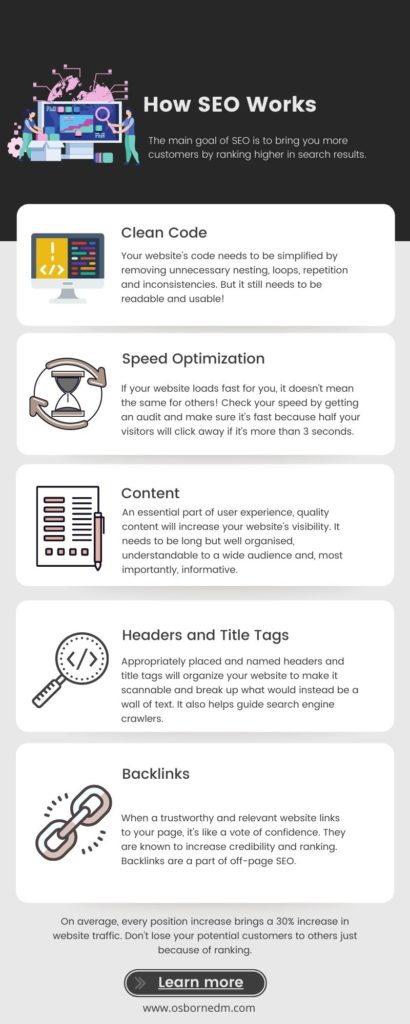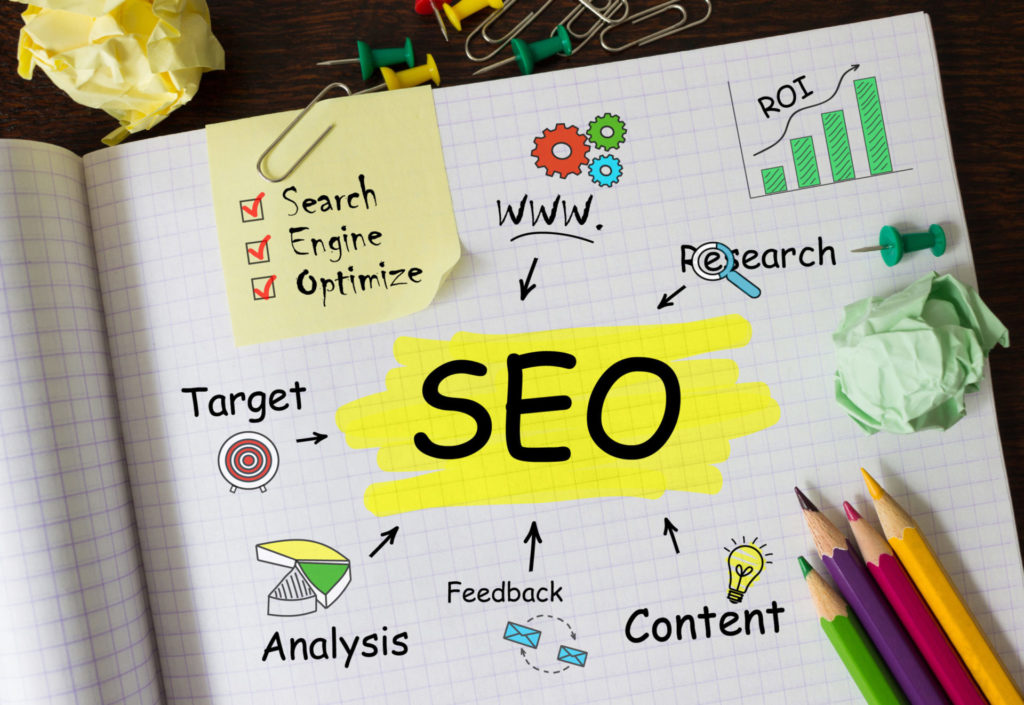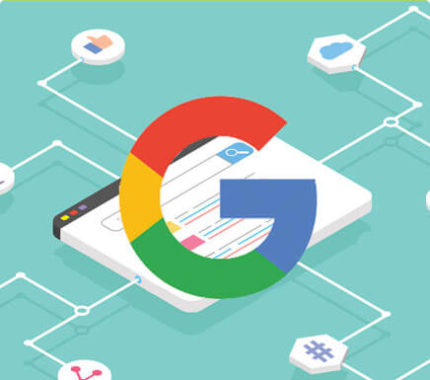We talk so much about SEO, and how important it is, but it’s also important to understand how SEO optimization works. In general, it can be divided into on-page and off-page optimization.
On page optimization includes all the work done on the website itself. On page optimization techniques include cleaning up the website’s code, optimizing the speed, providing quality content, a good user experience and creating appropriate headers and title tags. The website itself gets “deep-cleaned” inside out.

Table of Contents
Clean Code Principles
Code has several functions. Your site visitors will only care how the resulting website looks, but since code also needs to be sometimes modified and its simplicity matters for search engines, it’s essential that it’s done right. You don’t want your website being built upon “dirty code,” resulting in being overlooked in search results.
Unnecessary complexity adds code where it’s not needed and anything extra should be excluded. For example, deep nesting can create difficult loops. It also means that all needless repetition should be avoided. Consistency is also valued as a part of clean code. That being said, you have to strike a balance between conciseness and readability, because you still want your code to be workable. There are numerous other standards dictating the right approach, which are unfortunately often overlooked.
Speed Optimization
Google has outright stated that speed is a ranking factor. To analyze speed, it’s not enough to load your website yourself or ask another user to do it. There are special tools that you can use to check the loading speed overall. One of them is our free website audit. Google justifies their preference by mentioning the statistic that if a website exceeds just 3 seconds of loading time, half the people who clicked the link leave the website.
To address slow loading speeds, several things can be done. In this situation, code again plays a vital role, and it should be improved with any excess sections and elements removed since they can stall loading. Special file compression tools can be used for HTML, CSS and JavaScript files. Special attention should be paid to images that need to be compressed by Photoshop so that the quality doesn’t suffer. Redirects also add to the loading time, and should be removed or optimized. Google also recommends to avoid the usage of blocking JavaScript. Basically, by applying this guidance as part of a comprehensive approach, the issue of low speed can be fixed.
Headers and Title Tags
Headers help organize your website and its content. They should be done well because they make articles scannable (a well-recognized priority) and they can contain keywords. They also help search engines’ “crawlers” search the website and display it as a result of relevant searches. There are several header tags, ranging from H1 to H6, that help guide the crawlers. H1 is the main header and it is the main source of information for human readers and bots alike. H2-H6 are subheadings that further break up what otherwise would be an unreadable wall of text. The headers should be structured logically, without over-focusing on keywords because then it could look inorganic and reduce user-friendliness. Out of all the elements described here, proper HTML headings are the easiest to edit because they don’t require extensive coding knowledge. Title tags should be done properly for the same reasons.
Content
Content can include articles, case studies and blog posts. To rank your content and generate leads from it, there are certain parameters that you should pay attention to. It’s not about stuffing your writing with keywords, but rather about creating a high-quality and useful source of information and making sure you use the relevant, appropriate keywords that make it helpful. SEO in content writing pays special attention to length – the longer, the better. That being said, it shouldn’t be a wall of text, and should be broken up properly. In the same sense, formatting should also be organized well. The content should preferably be readable by a wider audience, too much jargon in unnecessary places may not be the best choice if you want to target as many people as possible. Your text would also benefit from links to other pages of your website. Content writing is a fine art that, if done well, can bring many people to your website organically and save you money on marketing.
User Experience
According to Google, user experience (UX) has started influencing ranking for mobile users starting August 2021, and in February 2022 it will affect desktop ranking as well.
They have stated that content is more important, but where there are many pages with relevant content to the search, page experience can be the deciding factor that moves your page up in ranking.
First of all, loading times matter here too, both on mobile and desktop if they share the same URL. If there are separate URL’s for mobile and desktop, then only the corresponding speed matters for the user, depending on the device. They are part of “core web vitals,” which also include Cumulative Layout Shift (CLS), that describes unexpected shifts of elements on your page while it’s loading. The less that happens, the better. HTTPS is another factor to pay attention to. It secures your website and you need to make sure that it is served over HTTPS. All those things have been explicitly specified by Google and should be taken seriously.
Off-Page SEO
Now that we have discussed some on-page SEO, let’s look at what can be done outside the website itself. Off page SEO examples include backlinks and blog out-reach. Backlinks are when other websites link to yours because you have an interesting product or informative content. They are one of the most important ways that increase your website’s credibility and ranking. But not all backlinks are created equal. A very reputable, famous and most importantly, related website’s backlink can benefit you immensely, while an unknown, barely alive and unrelated website’s backlink can be useless. If the website is completely unrelated or inappropriate, Google may even suppress your website because it seems suspicious.
Blog outreach is when you contact bloggers or journalists relevant to your content and ask them to show it on their platform. Your content can be useful to many people, and reaching out to share it with others can be helpful to both the blogger and their readers. Spamming others won’t lead to results, but a personalized email explaining your content and its relevance to their work may win them over. You should tread carefully with blog outreach so that it’s meant to be useful for readers rather than pursuing ranking at any cost.
Off page and on page SEO will both improve your website and its visibility if done thoroughly and properly. Some changes are harder to make, some are easier but overall it’s worth the effort in the long run because your website will be doing its own marketing. Inbound marketing has the highest ROI. Why? Because of "intent." People are looking for what you have for sale.




